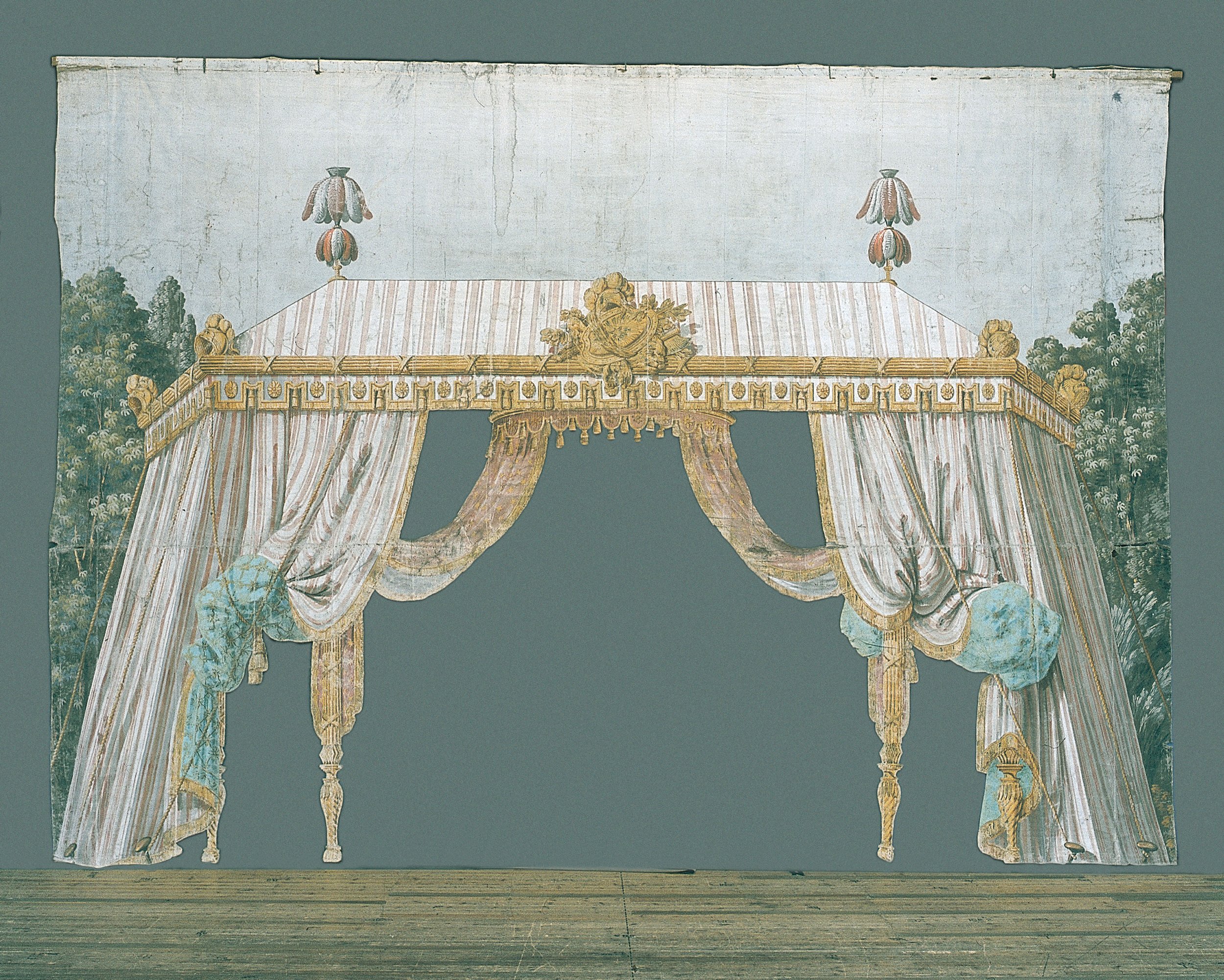the unique original scenery
“Two Backcloths making up the tent in the 3rd Act of Iphigénie en Aulide” DTM 414/1975. After cartoon by Jacob Mörck, dated 1786. Iphigénie en Aulide by C W Gluck was performed at Drottningholm on 13 August that year.
Nowhere else in the world is there a collection of 18th century theatre scenery that can surpass that preserved from Drottningholm Court Theatre. When theatre historian Agne Beijer entered the stage of the then untouched court theatre in 1921, he literally stumbled upon a cultural historical sensation. The original stage sets were lying in piles, in 'metre-high dust'.
In November 2023, the Swedish government allocated funds for heritage conservation measures and the preservation of the theatre's original scenery. Drottningholms Slottsteater has a unique position among the world's historic theatres. The government therefore considers it important to help preserve and make accessible the cultural and world heritage of the theatre.
In May 2023, Kungl. Vitterhetsakademien, the Royal Swedish Academy of Letters, History and Antiquities, also granted funds from Lars Lawski's fund for the conservation as one of several efforts to preserve cultural heritage buildings with the aim of promoting Swedish cultural heritage conservation.
The conservation of the original sets is an extensive and costly project that will require a lot of funding over a long period of time. In the future, the sets will need a new storage location other than the current storage building.
Do you want to contribute to the preservation of the theatre’s unique original scenery? Please contact Anna Hårleman De Geer via e-mail>>> or +46 76-88 919 00 for information on how you can support the project.
”A Ionic temple” DTM 206/1975. These sets are most likely painted by Carlo Bibiena himself. C G Gjörwell says in a letter of March 1774: "Night and day he [Bibiena] sits in the palace and paints for the new spectacle to be presented at the nuptial". This is the only known surviving stage painted by Carlo Bibiena.
The courts of Europe provided him with workshops and painters, as he was such a recognised artist. In Stockholm, Bibiena was given a brush and a week to finish. The artistry of his work is outstanding.
about the collection
The collection is of great importance for the knowledge of the flourishing theatre life of the 18th century in Sweden and Europe, with Queen Lovisa Ulrika and King Gustav III as initiators and developers. Since the theatre’s activities ceased after Gustav III's death, the stage sets were preserved in their existing condition instead of being worn out and thrown away over time, as was otherwise customary. The term unique should be used with caution but is fully relevant to this collection. It is the largest collection of historic stage scenery in the world and has never been preserved. The collection is unique as the authenticity of the objects is intact.
The more than 600 items in the collection are parts of stage scenery preserved from various productions, the earliest dating from the 1760s. The majority of the collection was made for Drottningholms Slottsteater, a total of 494 items. The scenery consists of backdrops, side flats, stage pieces and fabric ceilings, known as suffixes. Stage pieces refer to independent smaller parts of a larger set, such as trees and pieces of architecture. The backdrops are linen fabrics sewn together to form larger canvases and painted with glue paint. The backdrops and most of the scenery are made of wooden frames or beams to which linen fabric is nailed and painted with glue paint. Parts that are attached to the decoration can be made of other materials such as cardboard or textiles. Pins and staples are used.
The fact that outstanding Swedish and European artists not only designed but also often painted parts of the scenes themselves adds to the uniqueness of the collection and its cultural and historical value. Louis-Jean Desprez (1743-1804), Carlo Bibiena (1721-1787), Johan Pasch (1706-1796), Jean Eric Rehn (1717-1793), Jean-Démosthène Degourc (1749-1825) and Jacob Mörck (1748-1786) are just a few of the most prominent artists of the 18th century who handled the paint brush.
The scenes are varied: forests, gardens, ancient palaces, Gustavian rooms, a town street, a prison - the list of locations of the 18th century stage setting is long and imaginative.
The conservation methods and materials of the 19th and early 20th centuries often involved major interventions that affected both artistic execution and the composition of the materials. In many cases, the conservation measures carried out then have resulted in the distortion of the expression of the objects and shortened their lifespan. It is therefore positive for the cultural-historical values of the stage decorations that they were not conserved during this period.
During the 1930s and 40s, the original sets were used in the still rather modest activities of the theatre. When the stage came into more regular use after 1946, the original sets were gradually copied and the copies are now used in the productions.
During the late 20th century most of the collection was catalogued and photographed, resulting in Barbro Stribolt's book Scenery from Swedish Court Theatres. Drottningholm Gripsholm, published in 2002.
The unesco World Heritage designation
The Royal Domain of Drottningholm was designated as Sweden's first World Heritage Site by UNESCO in 1991. This means that the site has very high cultural and historical values and is classified as invaluable in an international perspective. The court theatre with its original fixed and loose interiors is of great importance for the World Heritage declaration and the original preserved scenery is specifically mentioned in UNESCO's description:
Detail of a set from the scenery "Garden" DTM 210/1975 by L J Desprez. This is an example of various techniques and materials. To create the impression of flowing water, silver-coloured textile threads have been stitched (back) and nailed (front) to the canvas.
time for conservation
The theatre's collection of original scenery is in need of conservation.
The careful conservation that is being applied on the buildings in the Royal Domain of Drottningholm at present involves as few additions and as minor interventions as possible. The planned measures on the theatre's original stage scenery are only intended to prevent decay and remove harmful external factors such as rusting metal staples. The plan does not include any attempt to recreate paintings or other decorations that have been lost. The proposed measures are considered necessary to preserve the collection of original stage decor for the future.
Patina is a historical trace of use that contributes to a stunning experience of time that has passed, and also conveys knowledge of how the objects have been used. Although the deterioration of materials should be stopped, it is important to preserve the patina of the scenery. All conservation work within the Royal Domain of Drottningholm has a reference group that includes the palace architect and antiquarian, in addition to conservators for various material categories. The group monitors the work and continuously discusses the question of patina and harmful decay, and how the balance between the two affects the conservation measures.



